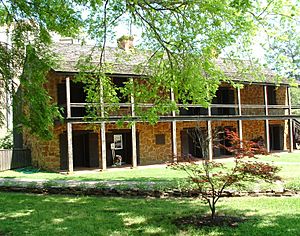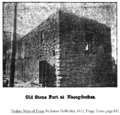Old Stone Fort Museum (Texas) facts for kids

Old Stone Fort
|
|
| Lua error in Module:Location_map at line 420: attempt to index field 'wikibase' (a nil value). | |
| Established | 1936 |
|---|---|
| Location | 1808 Alumni Dr. Stephen F. Austin State University Nacogdoches, Texas |
|
Recorded Texas Historic Landmark
|
|
| Official name | Old Stone Fort |
| Designated | 1962 |
| Reference no. | 9393 |
The Old Stone Fort Museum is a special place located at Stephen F. Austin State University in Nacogdoches, Texas. It's a museum that looks like an old building from the 1700s. This building is a copy, or "replica," built in 1936.
The original building was put up around 1779 by a local leader named Antonio Gil Y'Barbo. Even though it was called a "fort," it was never really a military fort. It was used for many different things over more than 100 years. Eventually, the original building was taken down.
The museum you see today was built with help from a local group called Cum Concilio. Money for its construction also came from a government program called the New Deal. Today, the museum is open to everyone. It has many interesting exhibits about the history of the area.
Contents
The Original Stone House: What Was It?
The first Old Stone Fort was built around 1779. It was made from local iron ore and was meant to be a trading house. Because of its strong stone walls, people called it the "Stone House."
Early Owners and Uses
In 1805, Antonio Gil Y'Barbo sold the Stone House. It was sold again in 1806 to William Barr. Barr and his business partners used it for their import-export company. They traded goods with the local Native American tribes.
One of Barr's partners, Peter Samuel Davenport, made the Stone House his main office. After his partners passed away, Davenport became the only owner. For several years, the building was also used by the government for different purposes.
A Place of Change
In 1826, a man named Benjamin Haden and his followers took over the building. This happened just before a conflict known as the Fredonian Rebellion. Later, a military leader named Colonel José de las Piedras used the Stone House as his headquarters.
In 1829, John Marie Durst bought the Stone House from Peter Samuel Davenport's son. Durst and his family lived there until 1834. Then, he sold it to Vicente Córdova.
After Texas became a republic in 1837, the building was used as a courtroom. A judge named Robert McAlpin Williamson worked there.
In 1838, Córdova sold the building to John S. Roberts. Roberts was an important person who signed the Texas Declaration of Independence. He had also been involved in important battles. Roberts ran different businesses in the Stone House. He later sold it to William and Charles Perkins, who were the last owners of the original building.
The Museum Today: A Replica Story
The Perkins family took down the original building in 1902. However, some of its original stones were saved by the Cum Concilio civic group. In 1907, this club used the stones to build a small structure in Washington Square.
Decades later, the New Deal program helped fund a new building. This new building was a copy of the old fort. It was built on the campus of Stephen F. Austin State College. The dedication ceremony for the new building happened on October 16, 1936.
This new building became the museum we know today. It is open to visitors and shares the history of the area through its exhibits.
Gallery
See also




